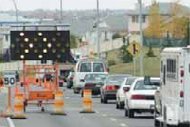Article from: www.thenewspaper.com/news/26/2684.asp
2/11/2009
Canada: Court Throws Out Work Zone Tickets without Workers
Winnipeg, Canada court decision finds workers must be present for a work zone speed camera ticket to be valid.
 "Work zone" speed camera tickets are invalid if they are issued in an empty work zone, according to a Winnipeg, Canada court ruling issued last month. Judicial Justice of the Peace Norman Sundstrom tossed citations issued to nine defendants who traveled through workerless work zones without exceeding the normal speed limit for the road they were on. The decision was based on a nuanced reading of the interplay between the provincial photo radar law and the law governing construction zone warning signs.
"Work zone" speed camera tickets are invalid if they are issued in an empty work zone, according to a Winnipeg, Canada court ruling issued last month. Judicial Justice of the Peace Norman Sundstrom tossed citations issued to nine defendants who traveled through workerless work zones without exceeding the normal speed limit for the road they were on. The decision was based on a nuanced reading of the interplay between the provincial photo radar law and the law governing construction zone warning signs.
"Although some people might feel that the legislation would be wiser to force drivers to slow down even after workers have gone home for the day, this is not in my view a justification for the court to add to or change the law under the guise of interpretation," Sundstrom ruled.
Manitoba law authorized the use of photo enforcement "in construction zones." A separate provision of the highway act described how temporary signs must be posted to indicate a drop in speed limit from, for example, 80km/h (50 MPH) to 60 km/h (37 MPH). The latter provision explicitly stated that such signs are to be used "while workers are present or using equipment in the construction zone." Sundstrom argued that ticketing when workers were not present defeated the fundamental goal of the work zone safety law.
"The purpose... in my opinion is ultimately to protect workers by setting out rules to follow," Sundstrom reasoned. "In these cases I find that sections 95(1.2) and 77(7.1b) show a clear clear intention on the part of the legislature to allow reduced speed signs in construction zones to be in effect 'when workers are present' and not otherwise."
None of the nine photo ticket recipients had exceeded the road's ordinary speed limit of 80km/h when they drove past empty work zones. The prosecution had argued that the 60km/h sign should be treated as a normal speed limit sign and that drivers should prosecuted for disobeying it. The work zone statute, prosecutors insisted, must be interpreted as protecting not just workers but drivers in general.
"The position taken by the crown here clearly seems to offend the general principle that there should be a consistent interpretation and enforcement of the law," Sundstrom concluded. "In my opinion the rule as set out in 95(1.2) will apply to any prosecution for speeding that occurs in construction zones, and that any reduced speed sign that was placed there essentially to make the zone safer for workers -- is enforceable only when workers are present."
While legislation allowing photo radar in construction zones is commonly promoted as a measure to protect highway workers, the data show that the driving public rarely causes injury to highway workers. Larry Stefanuik, a former police constable who now helps motorists fight traffic tickets, asked the Workers Compensation Board of Manitoba for the latest data on injuries in construction zones caused by motor vehicles. He found very few were caused by cars.
Number of highway worker injuries in Manitoba caused by automobile
2000: 2
2001: 2
2003: 1
2004: 2
2005: 2
2006: 1
"The high majority of collisions occurring in construction zones in Canada, involve vehicles belonging to the construction companies or their employees," Stefanuik wrote.
Manitoba accident data are consistent with work zone statistics from the US which show that most work zone fatalities are actually caused by construction vehicles. The full text of Sundstrom's decision is available in a 3mb PDF file at the source link below.
Source: Queen v. Boyko, et al. (Winnipeg, Canada Provincial Court, 1/27/2009)
Permanent Link for this item
Return to Front Page
 "Work zone" speed camera tickets are invalid if they are issued in an empty work zone, according to a Winnipeg, Canada court ruling issued last month. Judicial Justice of the Peace Norman Sundstrom tossed citations issued to nine defendants who traveled through workerless work zones without exceeding the normal speed limit for the road they were on. The decision was based on a nuanced reading of the interplay between the provincial photo radar law and the law governing construction zone warning signs.
"Work zone" speed camera tickets are invalid if they are issued in an empty work zone, according to a Winnipeg, Canada court ruling issued last month. Judicial Justice of the Peace Norman Sundstrom tossed citations issued to nine defendants who traveled through workerless work zones without exceeding the normal speed limit for the road they were on. The decision was based on a nuanced reading of the interplay between the provincial photo radar law and the law governing construction zone warning signs.